




|

I have always enjoyed the subject of dinosaurs and it seemed only natural to combine this interest with my paperfolding. The recent BBC series 'Walking with Dinosaurs' caused me to pick up some of favourite picture books from when I was young and to try and fold some of the creatures that I saw. I also discovered a lot more about these mighty prehistoric creatures. And so I have presented this page in the most informative fashion that I can. As well as photos and instructions for the dinosaurs, I have included scientific data and a brief description. Hopefully, this will stimulate your interest too.

|
Dinosaurs were large reptiles that inhabited the earth during the Mesozoic era, emerging 230 million years ago. They became extinct at the end of this period, 65 million years ago, possibly due to the after effects of a huge meteor striking the planet. Many other similar reptiles existed during this period too, including flying reptiles and oceanic reptiles.
|
Dinosaurs are classified into two main groups, which are further divided and sub-divided into many clades. These two main groups are the Saurischia and the Ornithischia.
Saurischia (meaning 'lizard-hipped')
This order includes all of the meat-eating dinosaurs and the large heavy long-necked plant-eaters. This order of dinosaurs evolved before the Ornithiscian order. There are two main clades, the Theropoda, which includes all of the carnivores and the Sauripodomorpha, which includes all the long-necked herbivorous dinosaurs.
Theropoda
Theropoda was a group containing all the two-legged meat-eating dinosaurs. They emerged during the late Triassic period and continued until the end of the age of dinosaurs. Ceratosauria were a group of primative theropods and included Coelophysis and probably Procompsognathus. Herrerasauridae were another primative group. The Tetanurae were a more advanced group, and included Carnosauria (such as Allosaurus) and the Coelurosauria. This group contained the Tyrannosauridae, the Ornithomimidae and the Mairaptora.
pro-KOMP-sog-NATH-us
(before delicate jaw)
Dr E. Fraas (1913)
Europe
Late Triassic
1.2m
|
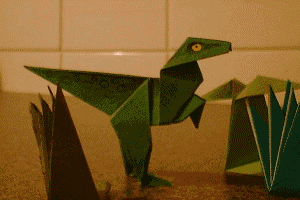
|
Procompsognathus may have been one of the earliest ceratosaurs. It was one of the smallest ever dinosaurs and was probably a fast moving scavenger. In the novel Jurassic Park, they were bred to digest the faeces of the other dinosaurs (yuck). Some controversy has arisen as to whether the skull of the specimein dicovered was that of procompsognathus or of an early crocodilian, so its classification is uncertain.
komp-SOG-nath-US
(delicate jaw)
Dr J.A. Wagnar (1859)
Europe
Jurassic
1.4m
|
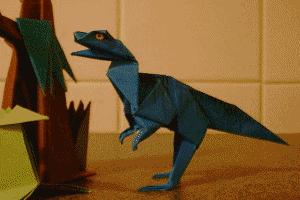
|
Composgnathus was a hen-sized dinosaur from the Jurassic period. This little scavenger lived in herds during the Jurassic period in the areas now know as France and Germany. When the original skeleton was found, the head was arched up over the head, suggesting that the animal died in agony. This gave support to one theory that some jurassic dinosaurs died out due to poisoning. It has later been noticed that when some birds die, this arching is actually due to neck muscles drying out.
SEEL-oh-FY-sis
(Hollow-form)
Dr E.D. Cope (1889)
North America
Late Triassic
3m long
|
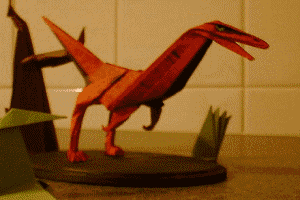
|
Coeophysis is one of the oldest well-known dinosaurs. In 1947, hundreds of these creatures were found in New Mexico. They were slim agile scavengers that emerged towards the end of the Triassic period. Their fast speed and water conserving physiology meant that they could out-compete many of the most ancient reptiles of the Triassic era. As well as having strong claws, Coelophysis had a mouth full of sharp teeth, indicating its carnivorous status.
AL-oh-SAW-rus
(Different Reptile)
Dr O.C.Marsh (1877)
North America
Jurassic
12m long
|

|
Allosaurus was the main meat-eating dinosaur of the Late Jurassic in North America. It had powerful jaws and sharp slashing claws on its forelimbs. At the time, it was the largest land carnivore on the planet, reaching sizes of up to 12 meters long.
Tie-RAN-oh-SAW-rus
(Tyrant reptile)
Prof H.F. Osborn (1905)
North America
Late Cretaceous
14m long
|
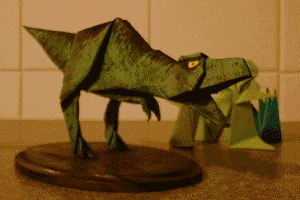
|
Tyrannosaurus is probably the best known dinosaur. It is the largest land carnivore that ever stalked the earth, being almost 6 meters tall. Although it had very small forelimbs, its jaws were massive, probably large enough to swallow a human whole. Its teeth, up to 30 cm long were serrated and were likely to have acted as reservoirs for toxic bacteria, making its bite semi-poisonous. Its long, heavily muscled legs and balanced body suggests that it could run fairly swiftly. It is still not sure whether T-rex was a hunter or a scavenger. I much prefer its portrayal as the berzerk killer as seen in Jurassic Park; a scavenger T-rex just wouldn't be any fun, would it?
vel-O-si-RAP-tor
(fast thief)
Prof. H.F. Osborn (1924)
Mongolia
Cretaceous
1.8m
|
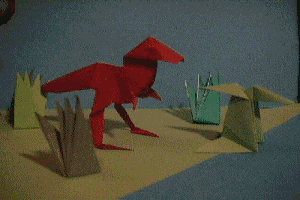
|
Velociraptor was a medium sized meat-eater. It was quite intellegent and may have hunted in packs. It had sharp claws on its forearms and a large scythe-like claw on the inside toe of each foot. They were probably not as dreadful as the monsters portrayed in the film Jurassic Park; they were a fair bit smaller than those portrayed. They were still vicious enough to prey on smaller dinosaurs such as Protoceratops. It was part of a group called Dromaeosauridae, a division of the Maniraptora.
DIE-no-NIKE-us
(Terrible-claw)
Dr J.H. Ostrom (1969)
Montana
Cretaceous
3m
|
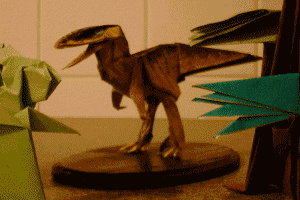
|
Deinonychus was similar to Velociraptor in shape but was much larger. As tall as a man, its foot claw was nearly a foot long. It would have used this to slash open its prey as it leapt on them. Its tail was stiffened and balanced the body, allowing deinonychus to attack with one foot at a time. This dinosaur too was a dromeosaurid.
Sauropodomorpha
Sauropoda includes all the big long-necked four limbed plant-eating dinosaurs that thrived during the Jurassic period. These creatures did not have the chewing ability of the Cretaceous Ornithopoda, so they relied on very long guts to digest their foot. As a result, they grew to a massive size. They decended from the Prosauropods. These earlier long-necked creatures evolved in the Triassic era, and walked on either two of four limbs.
MEL-an-O-roe-SAW-rus
(Black Mountain Reptile)
Dr S.H. Haughton (1924)
Africa
Late Triassic, Early Jurassic
12m
|
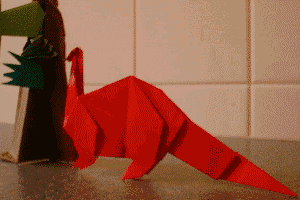
|
Melanorosaurus was a Prosauropod, an early ancestor of the Sauropods. It walked on all fours, unlike the earlier Plateosaurus which could walk on its hind legs. Not a great deal more is known about these earliest sauropodomorpha as only a few limb bones and vertabra have been uncovered.
Ornithischia (meaning 'bird-hipped')
This order includes a broad range of dinosaurs, all of which were plant eaters. This order evolved slightly later than Sauriaschians and later came to dominate the later period of the Mesozoic era. The main clades are Marginocephalia, Ornithopoda and Thyreophora.
Marginocephalia
Marginocephalia includes two groups, Ceratopsia and Pachycephalosauria. Ceratopsia includes all of the horned plant-eating dinosaurs. They were widespread throughout North America and Asia during the Cretaceous era. Two main groups were present, the short-filled ceratopsids and the long-frilled ceratopsids. Most ceratopsian had a curved bony beak at the front of the upper jaw which allowed them to snip off bunches of tough leaves. The Pachycephalosauria were a group of two-legged thick-skulled herbivores that existed during the Cretaceous era.
Styracosaurus
sty-RAK-oh-SAW-rus
(spiked reptile)
Dr L.M. Lambe (1913)
North America
Cretaceous
5.5m
|
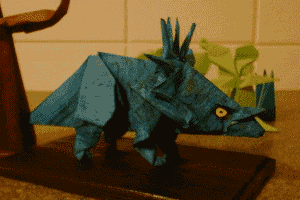
|
Styracosuarus is a well-known long-frilled ceratopsid. Most ceratopsids have small knobbly lumps around the edges of their frill. In sytracosaurus, these are fully developed. In this dinosaur, they were probably to warn off predators. They may not have been very effective as a shield as some parts of the frill were not solid bone.
try-SER-a-TOPS
(Three horned face)
Dr O.C. Marsh (1889)
North America
Cretaceous
9m
|
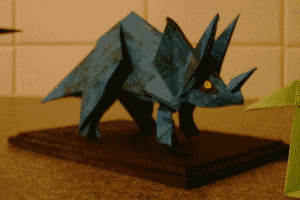
|
Triceratops was one of the largest Ceratopsids. It had three large horns, one emerging from its nose and two from above its eyes. It had a short frill which was surrounded by knobs of bone. The function of the frill is not fully known. It may have been used to signal to other dinosaurs. Triceratops had a large boney beak and grinding teeth to consume its herbivorous diet.
Ornithopoda
Ornithopoda is one of the most diverse groups, including 70+ species of plant-eaters. They were present all over the planet. They include Iguanadontidae, and Hadrousauridae, which included all of the duck-billed and crested dinosaurs. Several other families exist.
SAWR-oh-LOAF-us
(ridged reptile)
Dr B. Brown (1912)
Asia (Also North America)
Cretaceous
9-12m
|
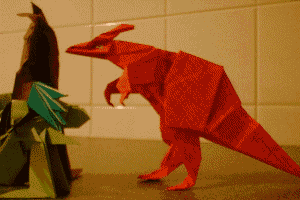
|
Saurolophus was an advanced crested duck-billed dinosaur. It had a large crest running backwards, which emerged as a tubular spike at the back of the skull. This structure was hollow and combined with loose skin at the top of its snout, it could have produced a huge bellow. The Asia species had a much longer spine, this is the one shown above. As in other duckbills, the front of the jaws had no teeth. Plant food was grasped bewteen the horn-covered duck bills at the front, and pulled back to be chewed by its many grinding teeth.
ig-WA-no-don
(iguana tooth)
Dr G.A. Mantell (1825)
Africa, Asia, Europe
Cretaceous
10m
|
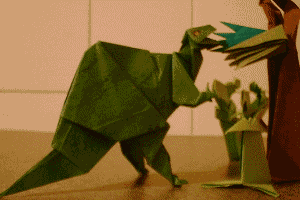
|
Iguanadon was the second dinosaur to be named, after Megalosaurus. It was a widespread herbivore found over most of the planet. It had strong hind limbs with three big toes, each with a hard hoof-like nail. The hand had four long fingers and a spike like thumb. The tail was flattened and stiff and Iguanadon could have run well on its hind legs or walked on all fours. There were no teeth at the front of the jaw - only a bony beak. The cheek teeth were strong and ridged and a long toungue probably helped it feed.
LAM-bee-oh-SAW-rus
(Lambe's reptile)
Dr W. Parks (1923)
North America
Cretaceous
15m
|
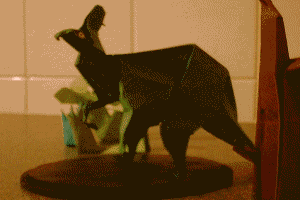
|
Lambeosaurus was a crested duck billed dinosaur with a square shaped crest pointing forwards and a long spine pointing backwards. The nostrils ran up from the snout and through the crest, so that the whole thing was hollow. It may have been used for a huge bellow. Lambeosaurus was big (15m long) and its bones are massive.
an-AT-oh-SAW-rus
(duck reptile)
Dr R.S. Lull & Dr N.E. Wright (1942)
North America
Cretaceous
10-13m
|
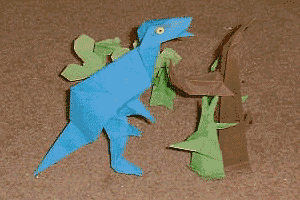
|
Anatosaurus was a classic 'duck-pilled' dinosaur. It had a low skull without a crest and a broad snout. This was a widespread herbivorous dinosaur with several different species. Parts of skin have been preserved and this suggests that the digits of the limbs were webbed, and may have been useful for swimming.
Thyreophora
Thyreophora contains two groups of medium to large sized armoured herbivores. The Stegosauria had spines or plates running down their backs. They existed mainly during the Jurassic period. The Anklosauria were heavilly armoured dinosaurs. Some were covered in spikes, some had spiked clubs on the end of their tails. They existed mainly during the Cretaceous era.
STEG-oh-SAW-rus
(roofed reptile)
Dr O.C. Marsh (1877)
Colorado
Jurassic
6-8m
|
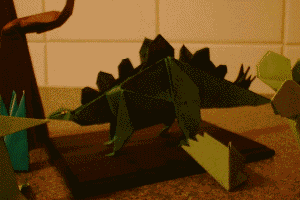
|
Stegosaurus was a large herbivore from the Jurassic period. Its most striking feature was two rows of diamond shaped plates along its back. The purpose of these is not fully know, they may have been for the regulation of heat, to signal to other dinosaurs or to make the stegosaurus look bigger. It also had four huge spikes on the end of a powerful tail that would have warned off predators. This dinosaur had a small head and a tiny brain, so was probably not the most coordinated creature ever to have existed. Its front legs were also a lot shorted than its hind legs, so it must have had a rather unusual walk.
An-KY-low-SAW-rus
(stiff reptile)
Dr B. Brown (1908)
North America
Cretaceous
10-17m
|
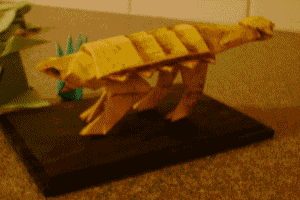
|
This huge herbivore was the size and shape of a military tank. Its powerful body was protected by plates of bone and an array of spikes. The tail was long and had a massive spiked club of bone at the end. This tail was highly muscled and the tail must have made a formidible weapon to any attacker, such as a tyrannosaur. The skull was highly armoured and covered in spikes. Ankylosaurus must have weighed a great deal too, and cannot have been a very fast moving dinosaur.
|




































































